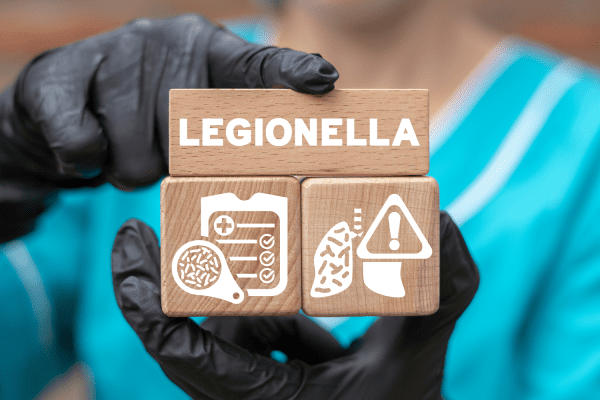Defending Your Water: Preventative Maintenance for Legionella
by Ben Frieders
Preventative Maintenance for Legionella
Legionella, a type of bacteria, can thrive in man-made water systems, posing a serious health threat. It causes Legionnaires’ disease, a severe form of pneumonia, and Pontiac fever, a flu-like illness. Fortunately, proactive maintenance strategies can significantly reduce the risk of Legionella growth in your water supply. This message will explore preventative maintenance practices and the crucial water quality parameters to monitor for optimal legionella control.
Understanding the Enemy: Legionella and its Ideal Habitat
Legionella bacteria are naturally occurring in freshwater environments. However, they become problematic when they multiply within complex plumbing systems like those found in buildings. Legionella thrives in warm, stagnant water, particularly within the temperature range of 77°F to 113°F (25°C to 45°C). Stagnant water is especially risky because it allows nutrients to accumulate, providing a breeding ground for bacteria. Here’s why regular maintenance is vital:
- Temperature Control: Maintaining proper water temperature is the cornerstone of Legionella control. Hot water should be kept at a minimum of 140°F (60°C) at the source, ensuring it reaches outlets at a safe temperature. Cold water should be stored and circulated below 68°F (20°C).
- Minimizing Stagnation: Regular use of all outlets helps prevent water from becoming stagnant. For infrequently used outlets, flushing weekly or implementing a flushing program is crucial.
- System Design and Maintenance: Complex plumbing systems with dead ends, low-flow areas, and poorly maintained components can harbor Legionella. Regular inspections and cleaning of these areas are essential.
Monitoring Water Quality: Key Parameters for Legionella Prevention
By monitoring specific water quality parameters, you can identify conditions favorable for Legionella growth and take corrective actions. Here are the key parameters to watch:
- Temperature: As mentioned earlier, temperature is the most critical factor. Regularly monitor hot and cold water temperatures at various points within the system, including outlets farthest from the source.
- Disinfectant Residual: Many water systems utilize disinfectants like chlorine to control bacterial growth. Maintaining a measurable disinfectant residual throughout the system ensures its effectiveness against Legionella.
- pH Level: The pH level of water affects the efficacy of certain disinfectants. Regularly measuring pH helps determine if the chosen disinfectant is working optimally.
- Conductivity: Water conductivity reflects the presence of dissolved minerals and can indirectly indicate potential for corrosion or biofilm formation, both of which can create an environment conducive to Legionella growth.
Developing a Water Management Program (WMP): A Proactive Approach
A comprehensive Water Management Program (WMP) is the foundation for effective Legionella control. This program should outline specific strategies for:
- Risk Assessment: Identifying areas within the water system with a higher risk of Legionella growth, such as dead ends, storage tanks, and low-flow fixtures.
- Monitoring Plan: Establishing a schedule for monitoring key water quality parameters like temperature, disinfectant residual, pH, and conductivity.
- Corrective Actions: Defining procedures for addressing situations where monitored parameters fall outside acceptable ranges. This may involve adjusting water temperature, increasing disinfectant levels, or cleaning specific equipment.
- Recordkeeping: Maintaining detailed records of all monitoring data and corrective actions taken.
Additional Considerations: Point-of-Use Filters and System Disinfection
In addition to the strategies outlined above, point-of-use (POU) filters certified to remove Legionella can be installed on specific high-risk fixtures. These filters provide an extra layer of protection for vulnerable individuals. For large-scale remediation efforts, system disinfection procedures using heat, chemicals, or a combination of both may be necessary.
Conclusion: Protecting Your Health Through Vigilance
Legionella poses a serious health threat, but proactive measures can significantly reduce the risk. By implementing a comprehensive preventative maintenance program that focuses on temperature control, minimizing stagnation, and monitoring key water quality parameters, you can safeguard your water system and the health of those who rely on it. Remember, a well-maintained water system is a healthy water system.
About The Author
Ben Frieders is the Business Development and Marketing Manager at ChemREADY, an industrial water treatment company, where he focuses on driving growth through strategic marketing, business development, and acquisitions. A former U.S. Navy Chief Petty Officer with a background in nuclear operations, Ben brings a unique blend of technical expertise and leadership to the water treatment industry. Certified in ASSE 12080 Legionella Water Safety and Management, he is a recognized expert in water quality standards, regulatory compliance, and Legionella risk management. Passionate about scaling businesses and optimizing systems, Ben combines data-driven strategies with a hands-on approach to help organizations achieve sustainable growth.

